iPad mini Review
by Anand Lal Shimpi & Vivek Gowri on November 20, 2012 6:10 PM ESTGPU Performance
Although most of the industry has done a great job in pushing CPU performance forward, Apple remains largely uncontested when it comes to mobile GPU performance. This isn't really due to some unsurmountable advantage, but rather a willingness to spend on SoC die area and incorporate big GPUs into its designs. The graphics IP all comes from Imagination Technologies, and although it's very well integrated by Apple, there are other SoC vendors that could push the envelope here - they simply have chosen not to.
Things are beginning to change as we saw with the introduction of Qualcomm's Adreno 320 based Snapdragon S4 Pro. NVIDIA's Wayne (Tegra 4?) SoC is expected to be much more competitive on this front as well.
As a result of many of the competing devices using slower GPUs, the mini looks a lot better in our GLBenchmark tests than its competitors.
We'll start out with the raw theoretical numbers beginning with fill rate:

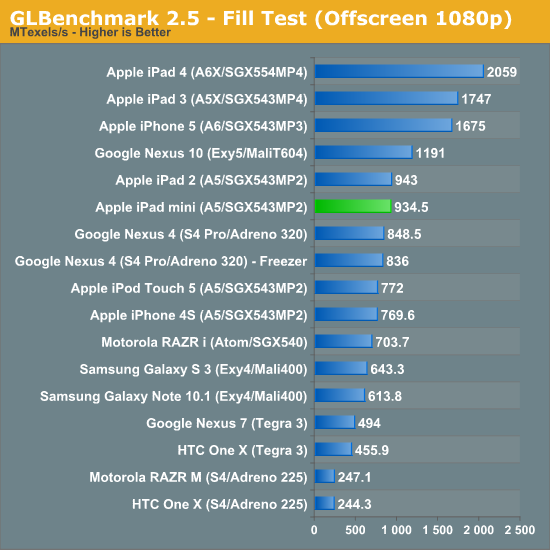
Other than the Nexus 10, the only devices that outperform the iPad mini here are other iPads or the iPhone 5. The mini's low native resolution will help ensure that gaming performance remains high for any currently available content.
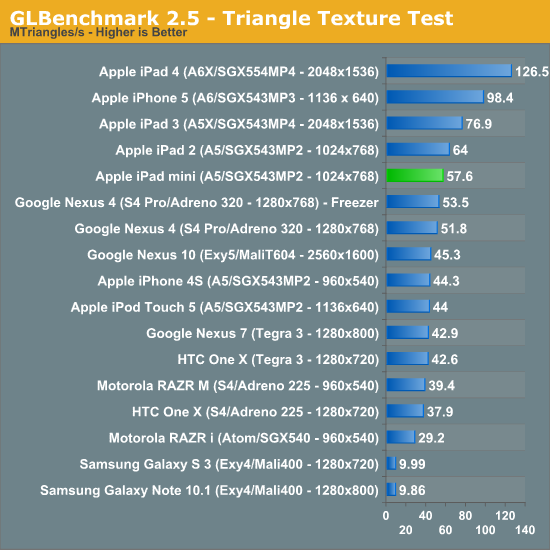

Triangle throughput looks very good here although the Tegra 3 based Nexus 7 is able to pull ahead on the offscreen test.
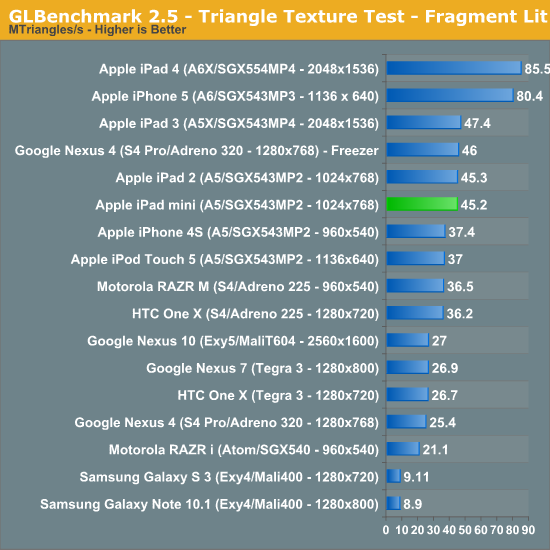
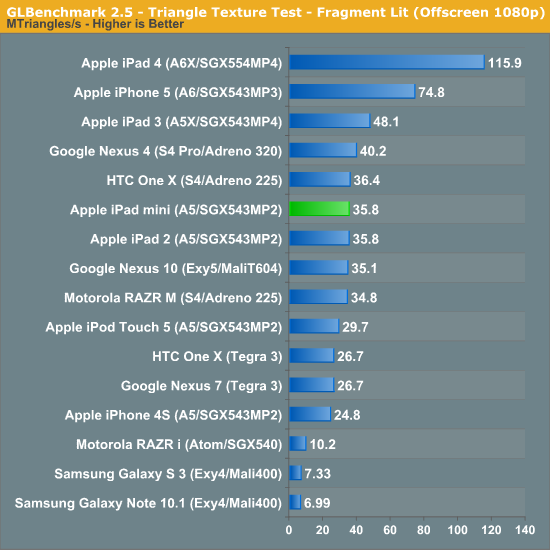
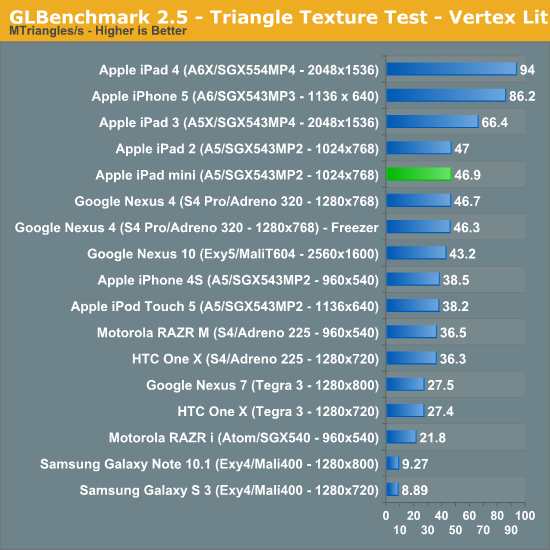
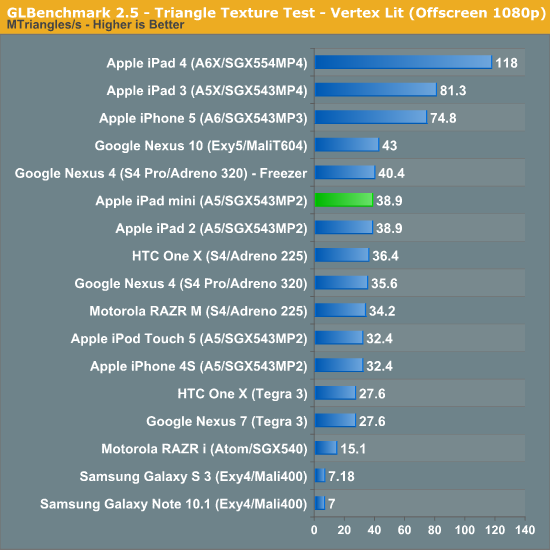
The mini continues to do quite well here vs the competition, although in the heavier triangle tests we see a clear difference between it and the A5X/A6/A6X based iOS devices.
With the synthetics out of the way, we can look at simulated game performance using the Egypt HD and Egypt Classic benchmarks. Remember the on-screen tests are run at native resolution with v-sync enabled, while the offscreen tests are run at 1080p with v-sync disabled for an architectural apples-to-apples comparison.
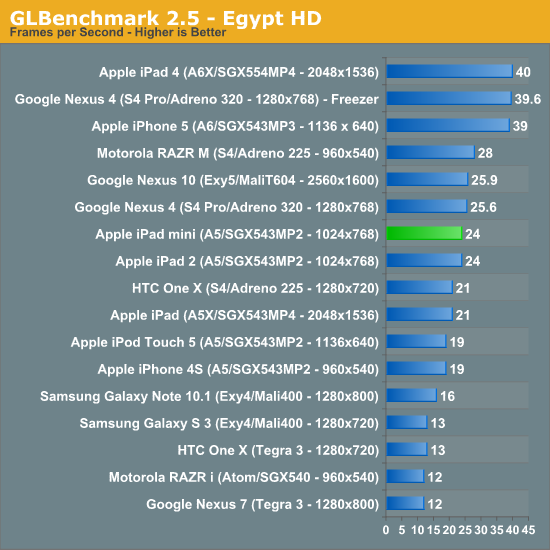
The mini does reasonably well running Egypt HD, which is a good indicator of future gaming performance on the device (perhaps ~2 years out for high end titles). The iPad 4's GPU does a good job of keeping up with its insane display resolution. The Nexus 7 doesn't fare nearly as well. Tegra 3 manages to run most current games just fine, looking forward though the GPU will probably not age too well.
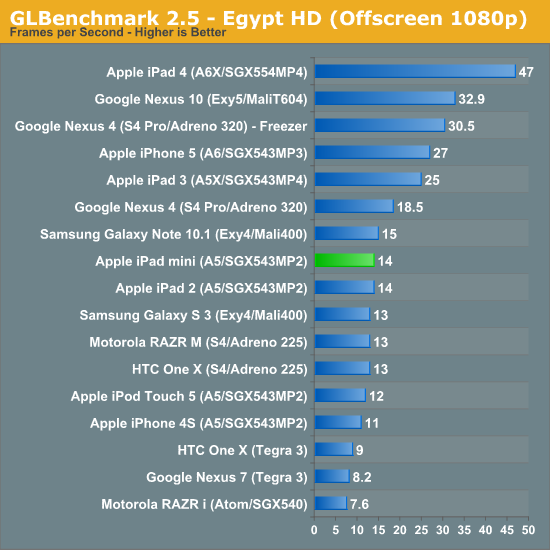
The offscreen tests show us what everything is really capable of given equal footing, and here the mini looks a lot more middle-of-the-road.
The Egypt Classic test is a much lighter workload, as a result most of these devices hit 60 fps at their native resolution:
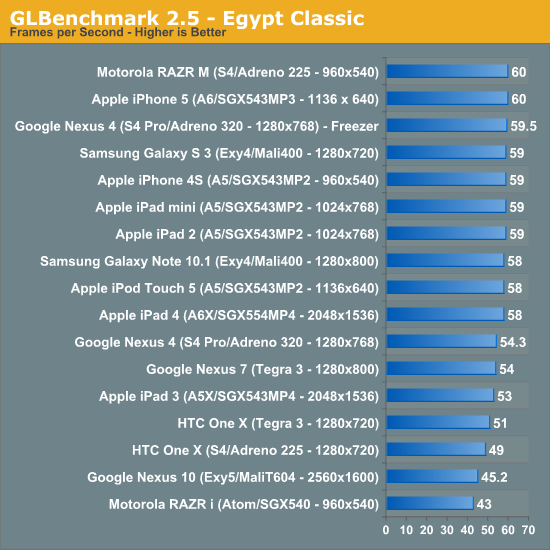
Although Egypt HD is a bit overkill for today's games, Classic undershoots by a good amount. The offscreen test however does provide some guidance as to whether or not these devices would be able to hit 30 fps on an appreciably heavier workload:

The mini does a good job here, although the iPad 3/4 and iPhone 5 are clearly quicker.
Overall the mini isn't a performance slouch. If you thought the iPad 2 was fast enough, the mini won't dissappoint. Its GPU remains very good and should be able to handle both present and upcoming iOS games. That being said, if Apple remains true to its typical cadence and gives next year's mini an A6 SoC I think that will end up being a much better match of price/performance.










140 Comments
View All Comments
Zink - Wednesday, November 21, 2012 - link
http://www.youtube.com/watch?v=5MMmLQlrBwstwtech - Tuesday, November 20, 2012 - link
I hope Google keeps the same screen size for the next 7" Nexus, but trims into the border a bit on the sides. Right now it's right at the limit for wrapping a hand around it, and I have pretty big hands.Crocography - Tuesday, November 20, 2012 - link
And also its all metal back is too slippery compared to the Nexus 7. I waited for both to be release before I bought the Nexus 7 32Gb. (bought one by selling my iPad 2013 model -- never really used it much)jjj - Tuesday, November 20, 2012 - link
If Apple is Apple they should have made this higher end and price it at 400$, and that still is what Job's Apple would do.Next year with the ipad 2 gone,they would need to drop the ipad 4 to 400$ or retire it so covering the 400$ range with the mini would make more sense.The cost of the SoC is a relative thing,32nm yields will get better by then,keeping it thin could be problematic if they double the res.PS; i am in no way suggesting this would be a price worth paying, just sayiing what would Apple do.
dishayu - Wednesday, November 21, 2012 - link
Is it possible Apple made the iPad mini worse than they were capable of, right now, just so that they can effortlessly update it and make more money out of it?ltcommanderdata - Wednesday, November 21, 2012 - link
Like any product designer, Apple has got to optimize for a variety of factors including component availability, component cost, final sale price, what features customers want, what features customers can tolerate not having, etc. If they just cared about maximizing profits they might as well have just thrown in the A4 from the iPhone 4 and a larger version of the TN panel used in the iPhone 3GS since they share the same dpi anyways.The iPad Mini already has worse battery life than the iPad 2 even without a retina display. Adding a retina display and a faster SoC to drive it will make this even worse unless a larger battery is included. One of the main features of the iPad Mini is how thin and light it is, even thinner and lighter than competing 7" tablets despite having a larger screen. Gaining a retina display in exchange for a thicker, heavier tablet may silence some complaints but will only create new ones. What's worse, a thicker, heavier design might make the iPad Mini difficult to hold given it's thin bezel design with limited grip area, so is a non-starter given current technology in 2012. Hopefully Anand is wrong in his prediction that a Retina iPad Mini isn't possible in 2013 either and that improvements in display tech, battery tech, and a move to the Samsung 28 nm process for the SoC will make it happen.
marcolorenzo - Wednesday, November 21, 2012 - link
Whilst I'm sure it was possible for Apple to include the retina display and the A6 SoC, it's more likely that they chose not to since it would make the device bigger and heavier due to the bigger battery it would require. Apple was simply not willing to make that sacrifice. Next year when the technology is more mature, they will implement it.drx11 - Sunday, November 25, 2012 - link
--------------------------------------------------------------------------RE: On purpose by marcolorenzo on Wednesday, November 21, 2012
Whilst I'm sure it was possible for Apple to include the retina display and the A6 SoC, it's more likely that they chose not to since it would make the device bigger and heavier due to the bigger battery it would require....
--------------------------------------------------------------------------
Exactly - this is the iPad 4 (gen)!
aravenwood - Wednesday, November 21, 2012 - link
Anand,Thanks for the article, but the most interesting thing you mention never gets explored at all in the article. On the first page you say:
"But here’s the thing - I don’t consider the iPad mini a competitor to the Nexus 7. The Nexus 7, to me, is what I buy if I’m in the market for a $199 tablet or I want a 7” Android device. It’s a completely different experience than the iPad mini. In my mind, the closest competitors for the iPad mini are, in order, the iPad 2, the Kindle Fire HD 8.9”, and the Nook Tablet HD+. The iPad 2 is obvious because these are the two lowest priced iOS tablets right now, and with similar underlying hardware, they’re actually pretty closely matched. I think the latter two are especially interesting comparisons to make, because all three exist in the ~$300 “small premium tablet” niche that has suddenly appeared."
You say that the comparison with the Nook HD+ and Kindle are the most interesting comparisons, in a small premium tablet niche, but you never come back to this. Can you elaborate on this, maybe in a followup article? I for one have basically discounted the iPad Mini, and the kindle in favor of the Nook HD+. I haven't bought it yet, but I am leaning heavily - the only drawback is the lack of camera and GPS. The price, quality of screen build quality is compelling. In general I feel that Nook HD/HD+ doesn't get the respect it deserves. I have been holding off because I can't any serious (e.g. Anandtech type) reviews of the device and i want to read some real discussion of it's qualities and get a no-bs assessment of the good and bad and comparison to the Kindle and nexus 10.
So that's my Thanksgiving wish - if you have down time, can we please have a review of the Nook HD +?
Thanks,
Michael
MadMan007 - Wednesday, November 21, 2012 - link
Seconded. The Nooks and Kindles may be some of the more popular tablets among the less tech savvy. They aren't the fastest or most up to date, but they do have nice feature sets, and B&N doesn't overcharge for built-in storage upgrades. The Nook HD+ and Fire HD 8.9" both have very high resolution screens. Maybe the custom software makes them harder to review? I still think it's worth it even if they aren't directly comparable to other tablets for that reason, plus you could explore loading custom ROMs if possible (I didn't bother to look up whether they are hackable)